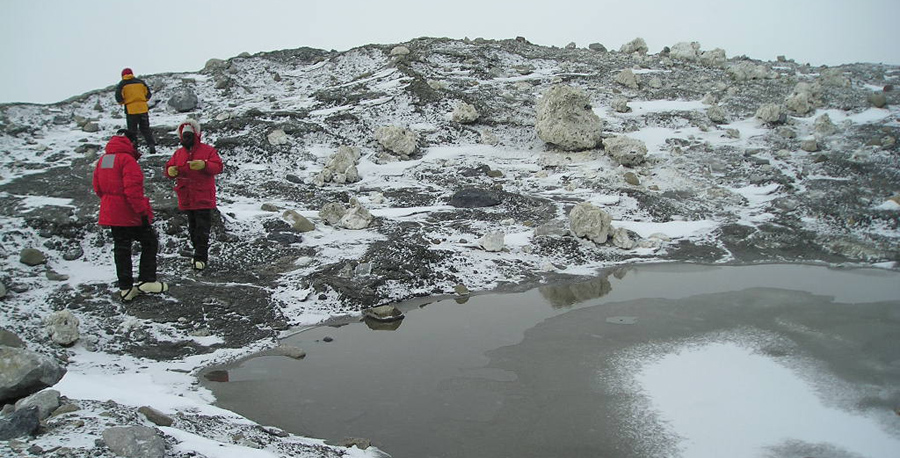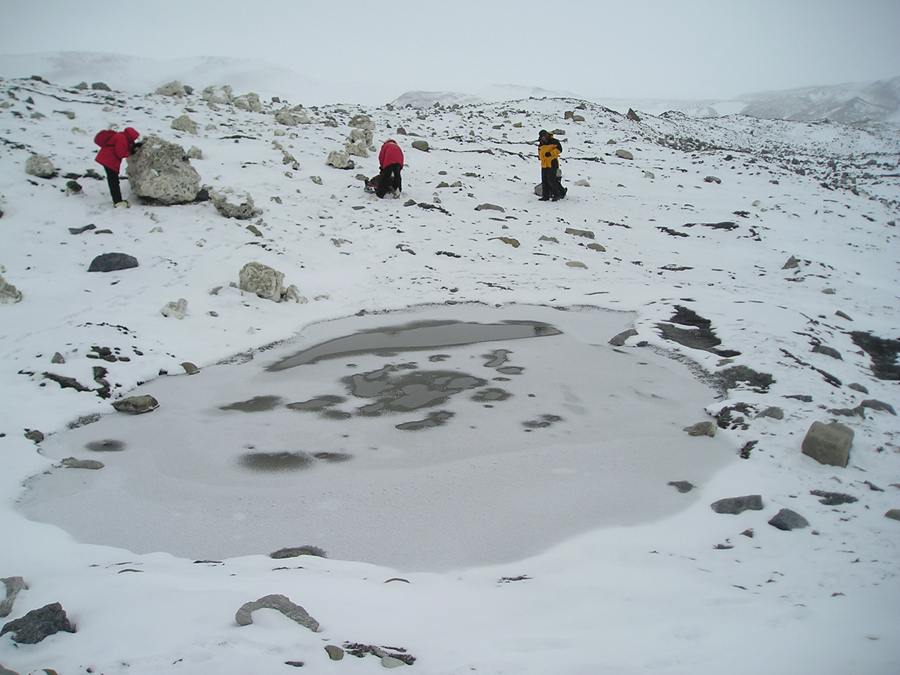
Photo Credit: Tao Sun
|
Scientists survey unusual sulfate formations near a small pond by the Lewis Cliff Ice Tongue.
|
The Lost Dry Valleys of the Polar Plateau
By Michael Lucibella, Antarctic Sun Editor
Posted October 21, 2015
Today the McMurdo Dry Valleys are a unique geographic feature in Antarctica, lowland regions away from the coast with no ice cover. However, new research indicates that there may have once been more places like them elsewhere on the continent.

Photo Credit: Tao Sun
Sulfate formations like these usually form at the bottom of deep lakes, but all the nearby bodies of water are much too small for such deposits to grow.
According to a recently published paper in Nature Communications, unusual mineral mounds discovered on the Lewis Cliff Ice Tongue along the Transantarctic Mountains are likely from an ancient dry desert near the South Pole, a region now buried under more than a mile of ice.
“There was a time where someplace in the interior of Antarctica was dry and ice free,” said Tao Sun, a geochemist at the University of Houston and lead author of the paper. “This dry valley must have existed somewhere between the Transantarctic Mountains and the South Pole.”
Though not the final word, the discovery strongly indicates that the continent’s interior ice sheets may be less stable than once thought. It’s evidence in a scientific debate that has been going on for years.
The evidence stems from large deposits of sulfates, in particular a sulfur-oxygen mineral called mirabilite. Large crystals of the mineral were found inside giant white mounds discovered on a 2006 expedition.
“This research started out like so many research projects, in a different way than it ended up,” said David Bish, a geologist at Indiana University in Bloomington and a member of the expedition that investigated the mountainous region.
The team went down in search of minerals that may have been pushed up to the surface by the flowing ice. The expedition was funded by NASA. The U.S. Antarctic Program supports all research on the southernmost continent, providing the logistics that facilitate the science. The National Science Foundation (NSF) manages the U.S. Antarctic Program.
NASA’s interest that it’s thought the region resembles the Martian surface.

Photo Credit: Tao Sun
A scientist surveys a large sulfate formation along the Lewis Cliff Ice Tongue near the southernmost tip of the Transantarctic Mountains. The glacier likely carried these deposits from farther south.
To their surprise they found unexpectedly numerous deposits of large sulfite compounds.
“Some of these mounds are probably the size of a Volkswagen and they were just sticking out of the top of the moraine,” Bish said. “If you see these mounds they’re chalky white on their exteriors and are obviously not ice if you look at them.”
Breaking through the chalky outer layers of the mounds, the team found giant, clear crystals of mirabilite, some nearly a meter across. The team sent specimens to Sun, who spent years processing and analyzing them.
“He kept hammering away at these data, trying to understand what the isotopic data were telling us,” Bish said.
Oxygen and sulfur, like all elements, come in various versions, known as isotopes. By looking at the chemical composition of the mirabilite, and its unusual ratio of different oxygen and sulfur isotopes, Sun was able to piece together a picture of how these crystals likely formed.
Mirabilite is made up of a combination of sulfur, oxygen, sodium and hydrogen. Crystals of it grow in sulfur-rich salt water.

Photo Credit: Tao Sun
Inside the sulfate mounds, the scientists found large, clear mirabilite crystals.
In the samples that he inspected, Sun saw an unusually high level of sulfur’s heavier isotope, sulfur-34, indicating that the lake these samples formed in was quite alive with microorganisms. Sulfur-eating bacteria prefer sulfur’s lighter isotopes and tend to leave behind its heavier forms. However, these bacteria can only live in deep water, below where oxygen molecules from the air mix with the water near the surface.
“These microbes do not like oxygen,” Sun said. “If there is oxygen then the reaction won’t occur.”
However there were no deep, microbe-rich lakes anywhere near the area where the samples were found--only a couple of shallow ponds not much bigger than swimming pools, far too small to sustain any kind of significant mirabilite growth.
“The areas didn’t have the environments to make that happen,” Sun said. He added that the mirabilite had to have been carried from another region by the glacier they were found on.
In addition to the crystals, the glacier also carried some of the sulfate-rich soil that surrounded the crystals at their original source, offering another clue about the environment where they formed. Sulfates extracted from the soils showed an excess of the oxygen-17 isotope, an indication that the water they formed in had to have been exposed to air. Water under glaciers doesn’t have this same signature, so these sulfate crystals couldn’t have formed in water surrounded by ice.
“Only in places like the Dry Valleys or the Atacama [Desert] in Chile, with millions of years of hyper-arid history, do you see accumulations of these kinds of sulfates,” Sun said.
The McMurdo Dry Valleys near McMurdo Station, NSF’s logistics and scientific hub in Antarctica, are some of the few places on the continent not covered in ice. They’re unique, as nearly all of the other ice-free regions are either along the coast or on the peaks of mountains poking through the blanketing ice sheets.
Oxygen isotopes in the sulfates’ embedded water molecules showed that they couldn’t have formed long ago, geologically speaking. Melted glacial water likely fed the lakes where the sulfates formed, and the oxygen signature matches that of modern-day glacial ice. Glaciers in that region started to form roughly 15 million years ago, so the lakes would have had to have formed after that. Other research indicates that there was a period of warming during the Pliocene era between about 2 and 5 million years ago, making it the most likely candidate for when sections of the Antarctic Plateau were last ice free.
According to Sun, the sulfates formed between about two and five million years ago, during the Pliocene era. As the climate shifted, they were covered by a glacier that preserved them in ice as it flowed down range. They emerged to the surface as they were pushed upwards and the ice encasing them sublimated away. Sun estimated that these crystals popped out of the flowing glacier no more than about 10 thousand years ago.
Researchers don’t know the precise location where these deposits first formed, but the path of the glacier indicates that it’s likely from somewhere closer to the South Pole, a region that hasn’t been ice-free in millions of years.
Exactly how long since the area near the pole has been ice free has been a matter of debate for nearly thirty years. Some scientists estimate that ice has covered the entire region for at least 15 million years, while others maintain that the sheets are more variable and some areas may have been devoid of ice as recently as 3 million years ago. Sun’s analysis indicates that the latter interpretation may be the correct one.
“There must be a transition somehow that triggers the ice cap collapse,” Sun said.
He added that more work still needed to be done to better understand how, where and when this collapse happened, and whether it bears any similarity to the warming climate conditions today.
This research was funded by NASA’s Mars Fundamental Research Program grant number NNF05GL75G with the support of the NSF’s Division of Polar Programs.








